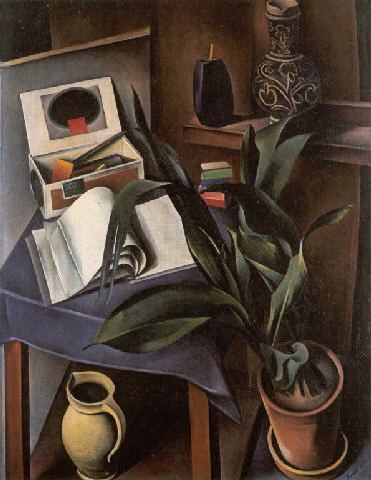Alexander Kanoldt on:
[Wikipedia]
[Google]
[Amazon]
Alexander Kanoldt (29 September 1881 – 24 January 1939) was a German magic realist painter and one of the artists of the

 Alexander Kanoldt was born on 29 September 1881 in
Alexander Kanoldt was born on 29 September 1881 in
Ten Dreams Galleries
1881 births 1939 deaths Artists from Karlsruhe 20th-century German painters 20th-century German male artists German male painters {{Germany-painter-stub
New Objectivity
The New Objectivity (in german: Neue Sachlichkeit) was a movement in German art that arose during the 1920s as a reaction against expressionism. The term was coined by Gustav Friedrich Hartlaub, the director of the ''Kunsthalle'' in Mannheim, wh ...
.
Early life and education

 Alexander Kanoldt was born on 29 September 1881 in
Alexander Kanoldt was born on 29 September 1881 in Karlsruhe
Karlsruhe ( , , ; South Franconian: ''Kallsruh'') is the third-largest city of the German state (''Land'') of Baden-Württemberg after its capital of Stuttgart and Mannheim, and the 22nd-largest city in the nation, with 308,436 inhabitants. ...
in Baden-Württemberg, Germany. His father was the painter , a late practitioner of the Nazarene style.
After studies at the Academy of Fine Arts Karlsruhe
The State Academy of Fine Arts Karlsruhe () is an art school located in Karlsruhe, Baden-Württemberg, Germany.
History
The Academy was founded in 1854 by Frederick I, Grand Duke of Baden, with the landscape painter Johann Wilhelm Schirmer a ...
he went to Munich
Munich ( ; german: München ; bar, Minga ) is the capital and most populous city of the German state of Bavaria. With a population of 1,558,395 inhabitants as of 31 July 2020, it is the third-largest city in Germany, after Berlin and ...
in 1908, where he met a number of modernists such as Alexej von Jawlensky
Alexej Georgewitsch von Jawlensky (russian: Алексе́й Гео́ргиевич Явле́нский, translit=Alekséy Geórgiyevich Yavlénskiy) (13 March 1864 – 15 March 1941), surname also spelt as Yavlensky, was a Russian expression ...
, Wassily Kandinsky
Wassily Wassilyevich Kandinsky (; rus, Василий Васильевич Кандинский, Vasiliy Vasilyevich Kandinskiy, vɐˈsʲilʲɪj vɐˈsʲilʲjɪvʲɪtɕ kɐnʲˈdʲinskʲɪj; – 13 December 1944) was a Russian painter a ...
and Gabriele Münter
Gabriele Münter (19 February 1877 – 19 May 1962) was a German expressionist painter who was at the forefront of the Munich avant-garde in the early 20th century. She studied and lived with the painter Wassily Kandinsky and was a founding mem ...
. He became a member of the Munich New Secession
Secession is the withdrawal of a group from a larger entity, especially a political entity, but also from any organization, union or military alliance. Some of the most famous and significant secessions have been: the former Soviet republics l ...
in 1913, with Jawlensky and Paul Klee
Paul Klee (; 18 December 1879 – 29 June 1940) was a Swiss-born German artist. His highly individual style was influenced by movements in art that included expressionism, cubism, and surrealism. Klee was a natural draftsman who experimented ...
.
Career
After military service inWorld War
A world war is an international conflict which involves all or most of the world's major powers. Conventionally, the term is reserved for two major international conflicts that occurred during the first half of the 20th century, World WarI (1914 ...
I from 1914 to 1918, the still life
A still life (plural: still lifes) is a work of art depicting mostly inanimate subject matter, typically commonplace objects which are either natural (food, flowers, dead animals, plants, rocks, shells, etc.) or man-made (drinking glasses, bo ...
s Kanoldt painted show the influence of Derain and an adaptation of cubist
Cubism is an early-20th-century avant-garde art movement that revolutionized European painting and sculpture, and inspired related movements in music, literature and architecture. In Cubist artwork, objects are analyzed, broken up and reassemble ...
ideas.
By the early 1920s Kanoldt developed the manner for which he is best known, a magic realist rendering of potted plants, angular tins, fruit and mugs on tabletops.Michalski 1994, p. 85. He also painted portraits in the same severe style, as well as geometrical landscapes. In 1925 he was made a professor at Breslau Academy, a post he held until 1931. During this time he came into conflict with the Bauhaus
The Staatliches Bauhaus (), commonly known as the Bauhaus (), was a German art school operational from 1919 to 1933 that combined crafts and the fine arts.Oxford Dictionary of Art and Artists (Oxford: Oxford University Press, 4th edn., 20 ...
faction at the Academy, and he was increasingly at odds with the avant garde
The avant-garde (; In 'advance guard' or 'vanguard', literally 'fore-guard') is a person or work that is experimental, radical, or unorthodox with respect to art, culture, or society.John Picchione, The New Avant-garde in Italy: Theoretical D ...
. From 1933 until his resignation in 1936 he was the director of the State School of Art in Berlin.
With the rise of the Nazi
Nazism ( ; german: Nazismus), the common name in English for National Socialism (german: Nationalsozialismus, ), is the far-right totalitarian political ideology and practices associated with Adolf Hitler and the Nazi Party (NSDAP) in ...
regime in 1933 Kanoldt attempted accommodation, painting in a romantic style, but nonetheless many of his works were seized by the authorities as degenerate art
Degenerate art (german: Entartete Kunst was a term adopted in the 1920s by the Nazi Party in Germany to describe modern art. During the dictatorship of Adolf Hitler, German modernist art, including many works of internationally renowned artists, ...
in 1937.
He died in Berlin on 24 January 1939.
See also
* Magic realismNotes
References
*Michalski, Sergiusz (1994). ''New Objectivity''. Cologne: Benedikt Taschen. *Schmied, Wieland (1978). ''Neue Sachlichkeit and German Realism of the Twenties''. London: Arts Council of Great Britain.External links
Ten Dreams Galleries
1881 births 1939 deaths Artists from Karlsruhe 20th-century German painters 20th-century German male artists German male painters {{Germany-painter-stub